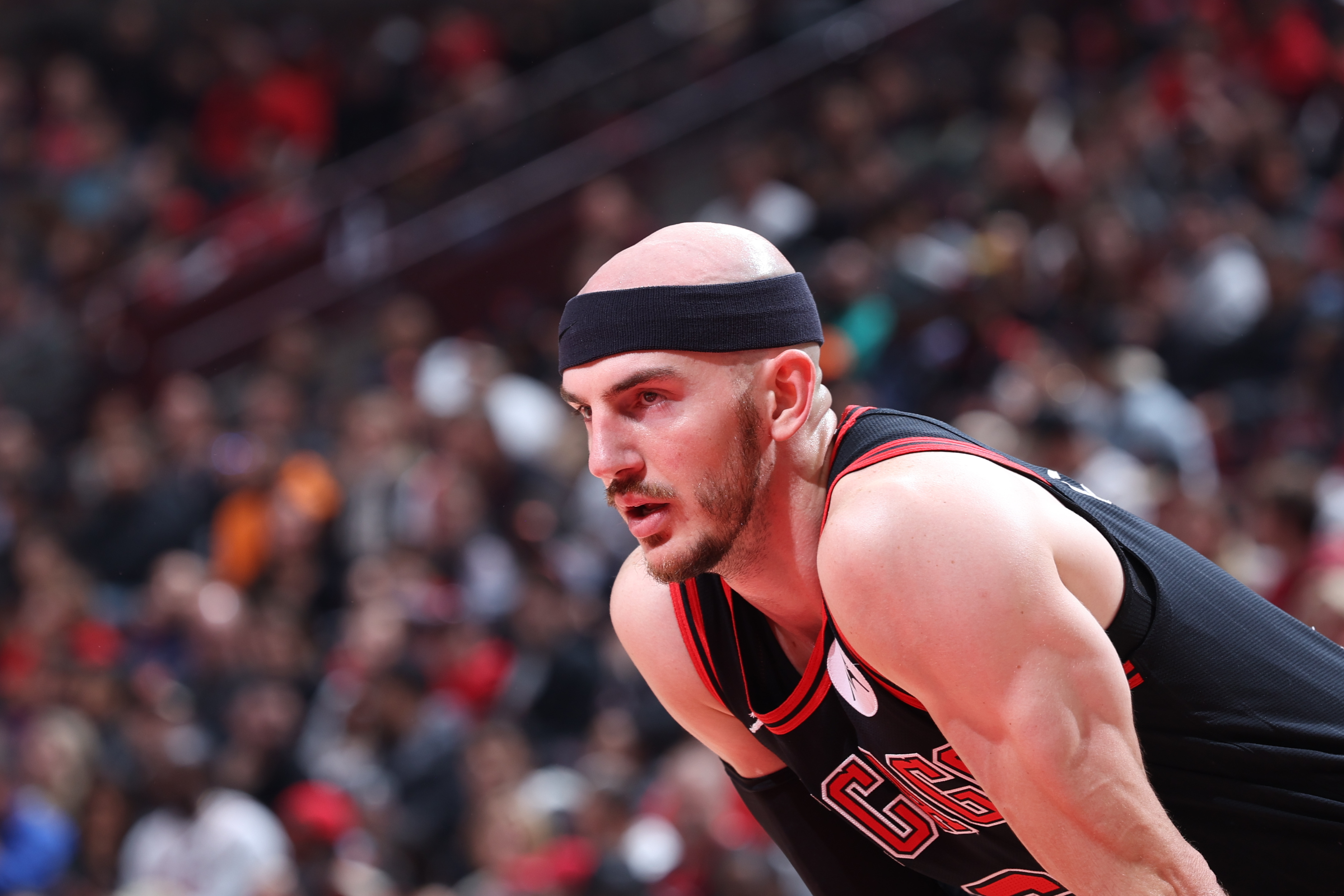
The inaugural class for the Illinois High School Basketball Hall of Fame and Museum in Pinckneyville was inducted in November in a gala ceremony in the Colonnades Club at Memorial Stadium in Champaign.
The class included 30 players from the pre-1960 era, 20 from the post-1960 era and 10 women.
Among the honorees present were La Grange's Ted Caiazza, Du Sable's Sweet Charlie Brown, Mount Vernon's Max Hooper, Proviso East's Jim Brewer, Champaign's Ted Beach, Lawrenceville's Jay Shidler, Canton's Dave Downey, West Aurora's Bill Small, West Rockford's Nolden Gentry, Springfield's Dave Robisch, Peoria Manual's Howard Nathan, Marshall's George Wilson, Marshall's Janet Harris and Kim Williams, Benton's Rich Yunkus and Tamms' Chico Vaughn.
Stay in the game with the latest updates on your beloved Chicago sports teams! Sign up here for our All Access Daily newsletter.
So who will be in the second class of inductees? Who just missed the first time around? Who is most deserving? And how many should be inducted? Ten in the pre-1960 era, 10 in the post-1960 era and five women? Five in each category?
The board of directors and the selection committee agreed that the inaugural class should be inclusive while also being exclusive, not too many. After all, major league baseball's Hall of Fame enshrined only five players in its first class in 1936 -- Babe Ruth, Ty Cobb, Walter Johnson, Christy Mathewson and Honus Wagner. That's elusive.
In the pre-1960 era, leading candidates are Elgin's Flynn Robinson and Don Sunderlage, Princeton's Joe Ruklick, South Shore's Jake Fendley, Taylorville's Billy Ridley, Galva's Rich Falk, Champaign's Rod Fletcher, Mount Vernon's Junior Kirk, Galesburg's Bumpy Nixon, Fenger's Sammy Esposito, Carrier Mills' Catfish Rollins, Rock Island's Richard Litt, Paris'
Dick Foley, Moline's Whitey Verstraete, Herrin's John Tidwell, Peoria's Hiles Stout, Dunbar's Bernie Mills, Crane's Tim Robinson, Bloom's Homer Thurman, Wells' Abe Booker and Mount Carmel's Jack Stephens.
In the post-1960 era, leading candidates are St. Anne's Jack Sikma, Eldorado's Mike Duff, West Aurora's Kenny Battle, Thornton's Lloyd Batts and LaMarr Thomas, Westinghouse's Kiwane Garris, Hersey Hawkins and Eddie Johnson, Hirsch's Rickey Green, La Grange's Owen Brown and Marcus Washington, Fenwick's Corey Maggette, Manley's Russell Cross, Marshall's Rich Bradshaw, Galesburg's Dale Kelley and Joey Range, Hales Franciscan's Sam Puckett, Simeon's Deon Thomas, Vocational's Juwan Howard, Rockford East's Skip Thoren, East St. Louis' Darius Miles, Madison's Don Freeman, King's Rashard Griffith, Carver's Terry Cummings, Farragut's Ronnie Fields, St. Francis de Sales' Eric Anderson, Peoria Manual's Frank Williams, Gordon Tech's Tom Kleinschmidt, Providence's Walter Downing, Jacksonville's Andy Kaufmann, Whitney Young's Quentin Richardson and Moline's Steve Kuberski.
News
And what about Dwyane Wade? A Richards graduate of 2000, the NBA all-star is eligible. So is Eddy Curry, a Thornwood graduate of 2001 and an NBA lottery pick. Players aren't eligible to be considered for Hall of Fame recognition until 10 years after they graduate from high school.
How would you like to pick five players from that elite group?
Leading women candidates are Marshall's Jennifer Jones, Maria Christian, Kim McQuarter and Toni Foster, Phillips' Shirley Joiner, Maine West's Nancy Kennelly, Sandburg's Sarah Kustok, Whitney Young's Natasha Pointer and Cappie Pondexter, Downers Grove North's Terri Zemaitis and Immaculate Heart of Mary's Michele Savage.
Obviously, the selection committee's job will be no less difficult in choosing the second class of inductees than it was in paring down the list for the inaugural class.
If that isn't tough enough, many basketball fans from throughout the state are nominating players who previously were flying under the radar but certainly have the credentials to warrant serious consideration.
The names include Reggie Murray of Cregier, Perry Barclift of Quincy, Roger Powell of Joliet Central, Billy Lewis of Farragut, Doug Collins of Benton, Bo Ellis of Parker, Bob Guyette of Ottawa Marquette, Lynch Conway of Peoria, Doug Altenberger of Peoria Richwoods, Dean Ehlers of Trico-Campbell Hill and Scott Steagall of Stewardson.
According to veteran Quincy historian Tom Oakley, Barclift rates behind only Bruce Brothers as the top Quincy product in the pre-1960s era, ahead of Bill Kurz of Quincy Notre Dame and Gary Phillips of Quincy. Barclift led the Blue Devils to the 1934 state championship, beating Lou Boudreau and Thornton. He scored 22 points in the state final, then a tournament record. He was a charter member of the Quincy Sports Hall of Fame.
While Oakley strongly supports the candidacy of Barclift and Michael Payne of Quincy's great 1981 team, he admits his personal favorite is Quincy's Larry Moore, who averaged 27.5 points in four tournament games in 1972.
"I personally feel Larry was the most exciting of all Quincy players, particularly from an offensive standpoint," Oakley said. "He was the Pete Maravich of Quincy High and set records that may never be broken. In his senior year, he scored 910 points and averaged 27.6 per game. This was before the three-point shot which, had it been in effect, would have dramatically increased his scoring totals."
A Hall of Fame without a representative from Galesburg? Longtime Galesburg sportswriters Mike Trueblood and Jay Redfern rate Bumpy Nixon (1959), Joey Range (1998) and Dale Kelley (1966) at the top of the list. Galesburg coach John Thiel said Nixon was the best player he ever produced. And veteran coaches Jerry Leggett, Duncan Reid and Frank Dexter said Range was among the top five players in the history of the Western Big Six Conference.
"From my research on Lynch Conway (who scored 22 points while leading Peoria to the first state championship in 1908), I suspect he might be one of the few folks from a century ago with the athletic ability to adjusttranslate to the skills necessary in today's game," said retired Peoria sportswriter Bob Leavitt.
Bruce Parmenter cited Scott Steagall of Stewardson, who played in 1947. "I played against him twice. He scored 27 in one game and 39 in the other. He was one of the first jump shooters and the best on the dribble-drive that I ever saw. He was an All-American at Millikin University and led the nation in scoring in his senior year, averaging over 30 per game," he said.
While Steagall had impressive credentials, he didn't earn All-State recognition in 1947. Dean Ehlers of Trico-Campbell Hill did. He led the state in scoring as a senior with 920 points, including games of 54, 60 and 63 points. He scored over 2,000 points in his career.
Longtime coach, scout and recruiting analyst Bill "Flash" Flanagan of Bloomington cited a host of post-1960s players whom he believes are worthy of Hall of Fame recognition. No. 1 on his list is Roger Powell of Joliet Central, a three-time All-Stater who led his team to third place in the 1970 state tournament as a sophomore and was the leading scorer in the state finals.
"Can you imagine if they would have had the three-point shot when he played?" Flanagan said.
His list also includes Billy Lewis of Farragut, Doug Collins of Benton, Jeff Wilkins of Elgin, Bo Ellis of Parker, Bob Guyette of Ottawa Marquette, Corey Maggette of Fenwick and Terry Cummings of Carver.
Collins is an interesting case. He didn't receive All-State recognition while playing at Benton. Between his junior year at Benton and his freshman year at Illinois State, he grew six inches but still retained his guard skills. As a sophomore, he was a first-team All-American. As a senior, he was the No. 1 pick in the 1973 NBA draft. And he was as standout on the 1972 U.S. Olympic team.
"There are a couple of other reasons why I would give Doug heavy consideration for the Hall of Fame," Flanagan said. "He has always been very generous in giving to good causes when it comes to the world of sports. Just ask Illinois State about that."
Guyette is often overlooked because he chose to play at Kentucky. The 6-8 center was a high school All-America at tiny Ottawa Marquette in 1971 but still took his team to the No. 9 ranking in the state at the end of the regular season -- a year before the two-class system was adopted.
"One night when I was representing Eastern Carolina," Flanagan recalled, "I was scouting Guyette in Ottawa along with Adolph Rupp (Kentucky), Sam Miranda (Kansas), Sam Esposito (North Carolina State) and Harv Schmidt (Illinois), just to name a few. As we know, Rupp got his man. And Guyette went on to have a great career at Kentucky. He was a big boy who could really play."


